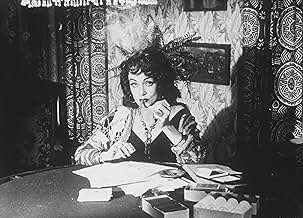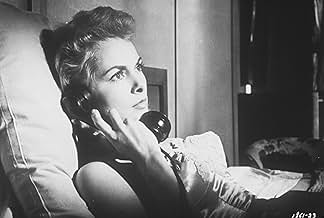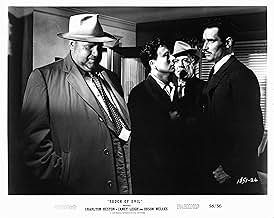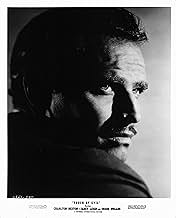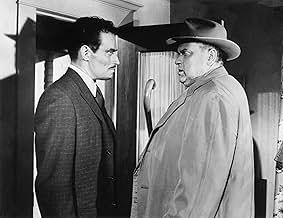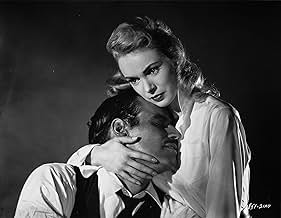Uma história crua e perversa de assassinato, sequestro e corrupção policial em uma cidade fronteiriça mexicana.Uma história crua e perversa de assassinato, sequestro e corrupção policial em uma cidade fronteiriça mexicana.Uma história crua e perversa de assassinato, sequestro e corrupção policial em uma cidade fronteiriça mexicana.
- Direção
- Roteiristas
- Artistas
- Prêmios
- 7 vitórias e 1 indicação no total
Valentin de Vargas
- Pancho
- (as Valentin De Vargas)
Avaliações em destaque
This suspense movie contains intrigue , thrills , plot twists and layered dialog prevail . A stark , perverse tale of murder , treason , kidnapping , and police corruption in a sleazy Mexican border town . As starring 'Mike' Vargas (Charlton Heston who cited not doing a Hispanic accent for his Mexican role as one of the biggest mistakes he ever made as an actor) has to interrupt his honeymoon along with his wife (Janet Leigh who initially rejected her participation in this film due to the low salary offered without even consulting the actress ) when an American building contractor is murdered . Idolized alcoholic Police Captain Hank Quinlan (Orson Welles) and his Sergeant, Pete Menzies (Joseph Calleia), are in charge on the US side and Hank soon has a suspect . But things go wrong when Vargas discovers Quinlan puts fake evidences against the prime suspect . Quinlan joins forces with Grandi (Akim Tamiroff) , who seeks revenge against Mike , to impugn Vargas's proofs .
This overwhelming masterpiece of the strangest vengeance ever planned is plenty of suspense and twisted intrigue from start to finish . Awesome opening , justifiable known , shot in stylistic way begins this over-the-top picture . ¨Touch of evil¨ failed in the U.S. but won a prize at the 1958 Brussels World's Fair , here director/player proved that he was still a filmmaking genius . Excellent acting by the great maestro Orson Welles playing the life of yet another ruthless character , he stars a corrupt inspector with a shady past and obscure present , planting evidences to detain suspects . Orson Welles was originally hired only to act in the film , but due to a misunderstanding, Charlton Heston thought that Welles was to be the director , to keep Heston happy, producer Albert Zugsmith allowed Welles to direct . Support cast is frankly magnificent , such as : Akim Tamiroff , Joseph Calliea , Dennis Weaver , Ray Collins , Joanna Moore , Marlene Dietrich , Zsa Zsa Gabor , among others . Oscar winner Mercedes McCambridge only appears in the film because she was having lunch with Orson Welles during filming and Welles convinced her to film a scene . Attractive and dazzlingly photographed in black and white by Russell Metty . The entire film was shot on real locations, apart from the infamous ten-minute take in the Mexican shoe store clerk's apartment, which is actually a set , Welles and Metty insisted on filming in a real city , settling for Venice, California, when he couldn't get his initial choice of Tijuana . Rousing jazzy musical score by the maestro composer Henry Mancini , including Latin rock sounds . Although much of the music used throughout the movie was from sound sources that pertained to the film: radio transmissions, jukeboxes, player piano . And being ulteriorly reconstructed according to Welles'notes in 1988 .
The motion picture was stunningly directed by Orson Welles who shot predominantly at night in order to fend off meddlesome studio suits . Welles was a genius who had a large and problematic career . In 1938 he produced "The Mercury Theatre on the Air", famous for its broadcast version of "The War of the Worlds" . His first film to be seen by the public was Ciudadano Kane (1941), a commercial failure , but regarded by many as the best film ever made , along with his following movie , The magnificent Ambersons . He subsequently directed Shakespeare adaptation such as Macbeth , Othelo and Chimes at Midnight or Falstaff . Many of his next films were commercial flops and he exiled himself to Europe in 1948 . In 1956 he directed this great masterpiece Touch of evil (1958) but Orson was fired as director during post-production, and the film was recut contrary to his wishes ; before his death, he left instructions on how he wanted the film to be edited, and in 1998 a version was made the way he intended . In 1975, in spite of all his box-office flops , he received the American Film Institute's Lifetime Achievement Award, and in 1984 the Directors Guild of America awarded him its highest honor, the D.W. Griffith Award . His reputation as a film maker has climbed steadily ever since.
This overwhelming masterpiece of the strangest vengeance ever planned is plenty of suspense and twisted intrigue from start to finish . Awesome opening , justifiable known , shot in stylistic way begins this over-the-top picture . ¨Touch of evil¨ failed in the U.S. but won a prize at the 1958 Brussels World's Fair , here director/player proved that he was still a filmmaking genius . Excellent acting by the great maestro Orson Welles playing the life of yet another ruthless character , he stars a corrupt inspector with a shady past and obscure present , planting evidences to detain suspects . Orson Welles was originally hired only to act in the film , but due to a misunderstanding, Charlton Heston thought that Welles was to be the director , to keep Heston happy, producer Albert Zugsmith allowed Welles to direct . Support cast is frankly magnificent , such as : Akim Tamiroff , Joseph Calliea , Dennis Weaver , Ray Collins , Joanna Moore , Marlene Dietrich , Zsa Zsa Gabor , among others . Oscar winner Mercedes McCambridge only appears in the film because she was having lunch with Orson Welles during filming and Welles convinced her to film a scene . Attractive and dazzlingly photographed in black and white by Russell Metty . The entire film was shot on real locations, apart from the infamous ten-minute take in the Mexican shoe store clerk's apartment, which is actually a set , Welles and Metty insisted on filming in a real city , settling for Venice, California, when he couldn't get his initial choice of Tijuana . Rousing jazzy musical score by the maestro composer Henry Mancini , including Latin rock sounds . Although much of the music used throughout the movie was from sound sources that pertained to the film: radio transmissions, jukeboxes, player piano . And being ulteriorly reconstructed according to Welles'notes in 1988 .
The motion picture was stunningly directed by Orson Welles who shot predominantly at night in order to fend off meddlesome studio suits . Welles was a genius who had a large and problematic career . In 1938 he produced "The Mercury Theatre on the Air", famous for its broadcast version of "The War of the Worlds" . His first film to be seen by the public was Ciudadano Kane (1941), a commercial failure , but regarded by many as the best film ever made , along with his following movie , The magnificent Ambersons . He subsequently directed Shakespeare adaptation such as Macbeth , Othelo and Chimes at Midnight or Falstaff . Many of his next films were commercial flops and he exiled himself to Europe in 1948 . In 1956 he directed this great masterpiece Touch of evil (1958) but Orson was fired as director during post-production, and the film was recut contrary to his wishes ; before his death, he left instructions on how he wanted the film to be edited, and in 1998 a version was made the way he intended . In 1975, in spite of all his box-office flops , he received the American Film Institute's Lifetime Achievement Award, and in 1984 the Directors Guild of America awarded him its highest honor, the D.W. Griffith Award . His reputation as a film maker has climbed steadily ever since.
Here is a film that wouldn't be made today because nobody makes 'B' movies anymore; and this is the greatest 'B' movie in the history of cinema. Here is the perfect example of why Orson Welles should be considered a genius. He has made this film look so effortlessly easy that it could almost be considered film making by numbers. From the famous opening sequence to the closing titles, this is the film students' reference book.
Welles portrayal of the bloated cop Hank Quinlan is only bettered by his Harry Lime in 'The Third Man'. He gets right inside the seedy, corrupt Quinlan; but still leaves room for just the lightest touch sympathy because we know that, after all, he's a fallible human like all of us. We almost feel sad at his fate especially when Marlene Dietrich gives her sad soliliquay about him.
This is another film that can only exist in black and white, and begs the question, why can't directors work effectively in this medium today? Some have tried but none have have really suceeded. David Lynch's Eraserhead is probably the best modern example of a black and white only film. Woody Allen's Manhattan tries hard but ends up looking too much like a documentary. I don't think that directors today use this medium enough, too many rely on colour and the efffects that can only work in colour to get them out of trouble.
So put A Touch Of Evil on your 'must see' list and enjoy a work of film making artistry.
Welles portrayal of the bloated cop Hank Quinlan is only bettered by his Harry Lime in 'The Third Man'. He gets right inside the seedy, corrupt Quinlan; but still leaves room for just the lightest touch sympathy because we know that, after all, he's a fallible human like all of us. We almost feel sad at his fate especially when Marlene Dietrich gives her sad soliliquay about him.
This is another film that can only exist in black and white, and begs the question, why can't directors work effectively in this medium today? Some have tried but none have have really suceeded. David Lynch's Eraserhead is probably the best modern example of a black and white only film. Woody Allen's Manhattan tries hard but ends up looking too much like a documentary. I don't think that directors today use this medium enough, too many rely on colour and the efffects that can only work in colour to get them out of trouble.
So put A Touch Of Evil on your 'must see' list and enjoy a work of film making artistry.
When anyone mentions this masterpiece they usually make some ignorant remark about Charlton Heston not being believable as a Mexican. Apparently such people think all Mexicans resemble the ones they've seen in the US who are mostly mestizo - 60% of Mexicans are Mestizo, 30% Indian and about 10% European. Well, Mexico's ruling class is predominantly of European ethnicity, and today many are educated in the US and so they speak fluent English with an American accent. Charlton Heston is playing a man who is a member of that elite and is thus believable in the role in terms of his physical appearance and possibly even his accent. The only problem came when his character had to speak Spanish! Now there he had a problem...
10Dr.Teeth
There are only two ways to write a review that would truly do this film justice. Either one would have to write an exceedingly long review, or a short, concise one. I choose to do the latter.
When I first saw "Touch of Evil," I was glued to the chair. When I found out it was not Welles' definitive vision, I wondered how on earth it could have been made better. And when I saw the re-released version, I wondered why the studio altered it. The stunning black-and-white images, the intricate plot, and the powerful, engaging performances took a hold of my imagination. At times, I imagined myself on the street with the characters, because the atmosphere was so thick I felt surrounded in it.
The actors all did an outstanding job, especially Leigh and Heston (who, although not thoroughly convincing as a Mexican, soared above his usual powerful, furious presence). This is Welles' picture, however, and whenever the camera catches his obese figure, you are fully aware of the man as a director and an actor. His powerful vision drives the film, from the single-cut opening sequence to the cat-and-mouse finale.
I suggest watching the 1998 restored version over the original theatrical release, but regardless of which version, "Touch of Evil" will have you stuck in your seat, questioning your views of morality until long after the last credit has rolled up the screen.
When I first saw "Touch of Evil," I was glued to the chair. When I found out it was not Welles' definitive vision, I wondered how on earth it could have been made better. And when I saw the re-released version, I wondered why the studio altered it. The stunning black-and-white images, the intricate plot, and the powerful, engaging performances took a hold of my imagination. At times, I imagined myself on the street with the characters, because the atmosphere was so thick I felt surrounded in it.
The actors all did an outstanding job, especially Leigh and Heston (who, although not thoroughly convincing as a Mexican, soared above his usual powerful, furious presence). This is Welles' picture, however, and whenever the camera catches his obese figure, you are fully aware of the man as a director and an actor. His powerful vision drives the film, from the single-cut opening sequence to the cat-and-mouse finale.
I suggest watching the 1998 restored version over the original theatrical release, but regardless of which version, "Touch of Evil" will have you stuck in your seat, questioning your views of morality until long after the last credit has rolled up the screen.
Touch of Evil has, perhaps, the BEST cinematography and lighting in ANY film ever made. Not just in the film noir genre, but in all categories. Orson Welles tended to use wide shots for all of his films, and Touch of Evil's use of wide shots took filmmaking to another level, especially with the amazing opening shot. The camera techniques and lighting are too spectacular to fathom, it is the grandmaster of all movies. Brilliant is an understatement. See this film, if not for the excellent acting and sheer brilliance in terms of the camera (this film had a GREAT D.P.!!), but for entertainment value. But if you are a film student or just want to see great camera work, Touch of Evil will astonish you.
Você sabia?
- CuriosidadesJanet Leigh's agent initially rejected her participation in this film due to the low salary offered without even consulting the actress. Orson Welles, anticipating this, sent a personal letter to the actress, telling her how much he looked forward to their working together. Leigh, furious, confronted her agent telling him that getting directed by Welles was more important than any paycheck.
- Erros de gravaçãoThe car that blows up four minutes into the film has the Texas plate AG 3724; 32 minutes into the film, police car number 10 also has the Texas plate AG 3724.
- Cenas durante ou pós-créditosOpening statement (restored version): In 1957, Orson Welles completed principal photography on TOUCH OF EVIL and edited the first cut. Upon screening the film, the Studio felt it could be improved, shot additional scenes and re-edited it. Welles viewed this new version and within hours wrote a passionate 58-page memo requesting editorial changes. This version represents an attempt to honor those requests and make TOUCH OF EVIL the film Orson Welles envisioned it to be. "... I close this memo with a very earnest plea that you consent to this brief visual pattern to which I gave so many long hard days of work." -- Orson Welles
- Versões alternativasA new version, running 111 minutes, has been restored by Universal and debuted at the Telluride Film Festival in September 1998. This version has been re-edited according to Orson Welles' original vision, as outlined in a 58-page memo that the director wrote to Universal studio head Edward Muhl in 1957, after Muhl took editing out of Welles' hands. The new version has been prepared by editor by Walter Murch, sound recordists Bill Varney, Peter Reale and Murch, and picture restorer Bob O'Neil under the supervision of Rick Schmidlin and film critic Jonathan Rosenbaum. One difference between the two versions is that the famous opening tracking shot is now devoid of credits and Henry Mancini's music, featuring only sound effects.
- ConexõesEdited into American Cinema: Film Noir (1995)
- Trilhas sonorasMain Title (Touch of Evil)
Written by Henry Mancini
Performed by United International Orchestra;
Rolly Bundock (bass); Shelly Manne (drums); Barney Kessel (guitar); Jack Costanzo, Mike Pacheco (percussion); Ray Sherman (piano); Dave Pell (baritone sax); Plas Johnson (tenor sax)Conrad Gozzo, Pete Candoli, Ray Linn (trumpets) ;Red Norvo (vibes)
Principais escolhas
Faça login para avaliar e ver a lista de recomendações personalizadas
Detalhes
- Data de lançamento
- País de origem
- Idiomas
- Também conhecido como
- Sed de mal
- Locações de filme
- El Rancho Courson Motel, SW corner of E Barrel Springs Rd and Courson Ranch Road, Palmdale, Califórnia, EUA(Mirador Motel - now site of a residential cul-de-sac)
- Empresa de produção
- Consulte mais créditos da empresa na IMDbPro
Bilheteria
- Orçamento
- US$ 829.000 (estimativa)
- Faturamento bruto nos EUA e Canadá
- US$ 2.247.465
- Fim de semana de estreia nos EUA e Canadá
- US$ 70.725
- 13 de set. de 1998
- Faturamento bruto mundial
- US$ 2.285.063
- Tempo de duração1 hora 35 minutos
- Cor
Contribua para esta página
Sugerir uma alteração ou adicionar conteúdo ausente

Principal brecha
By what name was A Marca da Maldade (1958) officially released in India in Hindi?
Responda


